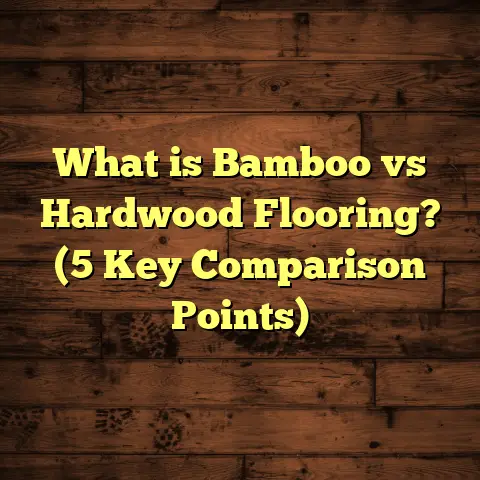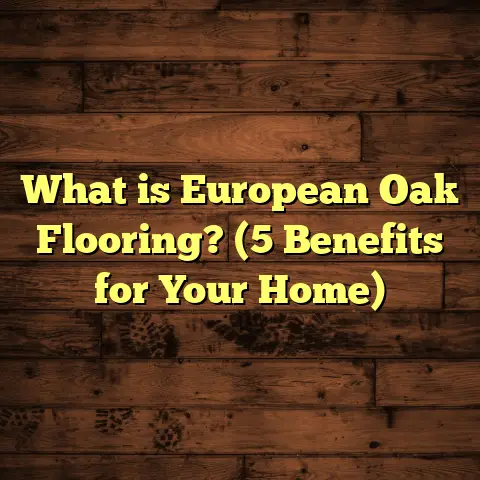What is Sustainable Wood Flooring? (5 Benefits for Eco Homes)
Luxury in a home often starts from the ground up—or, more precisely, the floor up. I’ve spent years working with homeowners who want their floors to be more than just a surface to walk on. They want floors that tell a story, floors that feel good underfoot, and floors that reflect values beyond aesthetics. Sustainable wood flooring strikes that perfect balance between elegance and responsibility. It’s wood flooring that does more than look stunning; it respects the planet while enhancing your home’s ambiance.
When I first encountered sustainable wood flooring early in my career, I was intrigued by how a simple choice of floor material could have such far-reaching effects—from reducing deforestation to improving indoor air quality. Over time, I’ve come to see sustainable wood flooring not just as a material choice but as a statement—a commitment to craftsmanship, nature, and future generations.
What Is Sustainable Wood Flooring?
So, what is sustainable wood flooring? Simply put, it’s hardwood or engineered wood flooring sourced and produced in ways that minimize environmental impact. This means the wood comes from forests managed to maintain their biodiversity, productivity, and ecological processes without depletion. It also means manufacturing practices aim to reduce waste and emissions.
Sustainable wood flooring is certified by organizations like the Forest Stewardship Council (FSC) or the Programme for the Endorsement of Forest Certification (PEFC). These certifications guarantee that the wood has been harvested responsibly, respecting both nature and local communities. When I choose sustainable wood flooring for a project, I always look for these marks—they’re a trustworthy sign that the product aligns with eco-friendly principles.
Digging Deeper Into Certifications
Let me break down why these certifications matter. The FSC certification process involves strict guidelines on forest management, including protecting water quality, preventing illegal logging, and preserving wildlife habitats. FSC also requires companies to engage with local communities and uphold labor rights.
PEFC operates similarly but focuses on mutual recognition of national forest certification systems, making it flexible globally but equally rigorous.
Beyond these two, other labels like SCS Global Services offer environmental claims verification for products that meet strict criteria such as low VOC emissions or recycled content.
Engineered Wood vs. Solid Wood in Sustainable Flooring
You might be wondering: is engineered wood flooring considered sustainable? The answer is yes—often even more so than solid hardwood. Engineered wood uses a thin layer of real hardwood on top of plywood or high-density fiberboard made from fast-growing trees or recycled wood fibers. This method maximizes use of raw materials while maintaining the look and feel of solid wood.
For example, engineered flooring can use less slow-growing hardwood per square foot compared to solid planks. This helps conserve older forests while still delivering durability and beauty.
In my projects, I frequently recommend engineered wood flooring for clients who want sustainability without sacrificing performance in humid or temperature-variable environments where solid wood might struggle.
The Science Behind Sustainable Forestry
Understanding sustainable forestry helps clarify what makes wood flooring truly eco-friendly. Sustainable forest management balances tree harvesting with natural regeneration rates. This means only trees that can be replaced naturally or through planting are logged.
Research shows that sustainably managed forests can actually store more carbon over time than unmanaged forests because young trees grow faster and absorb CO2 more rapidly.
According to the Food and Agriculture Organization (FAO), certified forests globally are growing at an annual rate of about 1 million hectares—proof that responsible forestry works.
Why Does Sustainable Wood Flooring Matter?
When I first started recommending sustainable wood flooring, some clients wondered if it was just a marketing buzzword or an expensive trend. But here’s what I found: sustainable wood floors offer real benefits beyond green credentials. They combine quality with environmental mindfulness, making them a smart choice for eco-conscious homeowners.
Traditional hardwood flooring can sometimes contribute to deforestation if harvested irresponsibly. Deforestation leads to loss of wildlife habitat, increased carbon emissions, and soil erosion. Using sustainable wood flooring helps combat these problems by supporting forest regeneration and protecting ecosystems.
On a personal note, I’ve installed sustainable wood floors in several homes built with eco-friendly designs—solar panels, rainwater harvesting systems, you name it. The flooring becomes part of an overall lifestyle that respects nature and reduces carbon footprints.
Environmental Impact: A Closer Look
Let me give you some numbers. The World Wildlife Fund estimates that about 18 million acres of forest are lost each year due to logging and land conversion. This loss contributes roughly 12-20% of global greenhouse gas emissions.
Choosing sustainable wood flooring means you’re part of a solution. FSC-certified forests ensure harvests are balanced by regrowth, preserving crucial carbon sinks.
A study published in the Journal of Cleaner Production found that using FSC-certified wood reduces carbon emissions by up to 30% compared to non-certified wood products. This reduction comes from better forest management practices and lower processing energy use.
Besides carbon savings, sustainable forestry protects biodiversity hotspots. For example, FSC standards require protecting areas where endangered species live—something conventional logging often overlooks.
Economic and Social Impacts
Sustainability isn’t just about trees; it’s also about people. Sustainable forestry supports rural economies by providing stable jobs and fair wages in many regions worldwide.
When I visit suppliers or manufacturers with strong sustainability commitments, I often hear stories about how responsible harvesting programs help fund community schools, healthcare, and infrastructure improvements.
This social angle adds meaning to my work because it shows how floor choices ripple out into real human benefits.
Five Benefits of Sustainable Wood Flooring for Eco Homes
Let me break down five key benefits I’ve observed firsthand when using sustainable wood flooring in eco homes:
1. Environmental Impact Reduction
Sustainable wood flooring significantly lowers your home’s environmental impact. Since it comes from responsibly managed forests, it promotes forest conservation and reduces illegal logging. Plus, the manufacturing process often uses less energy and produces fewer emissions compared to conventional methods.
For instance, the carbon footprint of sustainably harvested wood flooring can be up to 30% lower than non-certified wood products, according to research published by the World Resources Institute. That’s a substantial saving in greenhouse gases.
One time, I worked on a project where my client was deeply passionate about reducing their carbon footprint. Choosing FSC-certified oak flooring reduced their home’s embodied carbon by nearly 20% compared to other options we considered.
2. Healthier Indoor Air Quality
Some floors can off-gas volatile organic compounds (VOCs) from adhesives or finishes—bad news for indoor air quality. Sustainable wood flooring often uses low-VOC adhesives and finishes, making your living space healthier.
I remember fitting floors in a family’s newly built eco home where the parents were concerned about asthma triggers. We opted for sustainably sourced maple finished with natural oils and water-based sealers. The air quality improved noticeably, reflected in fewer respiratory issues reported by the family after moving in.
Indoor air quality impacts everything from allergies to cognitive function. Studies show that VOCs commonly found in traditional flooring finishes can cause headaches and irritation. Choosing floors with low or zero VOC finishes is an easy step toward a healthier home environment.
3. Durability and Longevity
Don’t think sustainability means compromising on quality. In fact, many sustainable wood floors are incredibly durable. Forests managed sustainably tend to produce hardwood species with dense grain structures that wear well over time.
In one renovation I handled, we used sustainably harvested hickory flooring known for its toughness. The homeowners told me two years later that their floors still looked flawless despite heavy foot traffic from kids and pets.
Long-lasting floors also mean fewer replacements down the road—less waste and less resource consumption overall.
According to the National Wood Flooring Association (NWFA), high-quality hardwood floors can last 100 years or more when properly maintained. Sustainable sourcing just adds an ethical layer without sacrificing this longevity.
4. Aesthetic Appeal That Ages Gracefully
Sustainable wood flooring brings natural beauty that improves with age. The grain patterns, color variations, and textures create warmth and character in your home’s design.
I personally love how reclaimed or sustainably sourced woods tell a story through their subtle imperfections and history. A client once shared how their engineered sustainable wood floor developed a rich patina over time, giving their living room a cozy, inviting vibe they hadn’t expected.
Unlike synthetic materials that can look flat or artificial over time, natural wood develops charm with wear—something many homeowners appreciate deeply.
5. Supporting Ethical Practices
Choosing sustainable wood flooring supports fair labor practices and local communities involved in forestry. These certifications require companies to follow ethical guidelines—no child labor, fair wages, and respect for indigenous peoples’ rights.
I worked with a supplier who partners with small-scale forest owners in Southeast Asia committed to sustainable harvesting. Knowing my client’s floor helped support those communities added an extra layer of satisfaction to the project.
This connection between your floor and distant communities often surprises people but highlights how global our choices really are.
How Sustainable Wood Flooring Fits Into Eco Home Design
Sustainable wood flooring isn’t just about the floor itself; it integrates seamlessly into eco home design principles. Here are some aspects I’ve seen work well:
- Energy Efficiency: Wood has natural insulating properties that help regulate indoor temperatures, reducing energy use.
- Renewable Resource: Wood is renewable when harvested responsibly—unlike synthetic flooring options made from fossil fuels.
- Biodegradability: At the end of its life cycle, wood can decompose naturally or be repurposed rather than creating landfill waste.
I once collaborated on an eco home where every material was chosen for its environmental profile—walls made of recycled materials, energy-efficient windows, and sustainably sourced walnut floors. The result was a harmonious space that felt warm and inviting without sacrificing conscience.
Thermal Comfort Benefits
Wood’s natural insulating properties reduce cold feet in winter and coolness in summer without additional heating or cooling loads—something especially valuable in eco homes designed for passive energy use.
A study by the University of Minnesota showed that homes with hardwood floors required up to 10% less heating energy compared to homes with ceramic tile floors due to better thermal insulation properties of wood.
This means your floor choice directly affects your home’s energy footprint beyond aesthetics or environmental impact alone.
Compatibility With Renewable Finishes
Many sustainable wood floors pair well with natural or water-based finishes derived from plant oils or resins rather than petroleum products. These finishes maintain low VOC levels while enhancing durability.
In one project involving children’s bedrooms, we used natural oil finishes on bamboo floors certified as sustainable—a combo that brought peace of mind regarding chemical exposure while keeping the floors resilient against wear.
What About Cost? Is Sustainable Wood Flooring Affordable?
Here’s something I hear often: “Isn’t sustainable wood flooring more expensive?” It can be slightly higher upfront compared to some conventional options due to certification costs and sourcing challenges.
But consider this: sustainable wood floors tend to last longer and require less maintenance, which reduces lifetime costs. Plus, many homeowners find value in supporting ethical production and environmental stewardship.
For example, using FloorTally or similar tools helps me provide clients with clear cost estimates that factor in regional material prices and labor rates for sustainable products. This transparency helps avoid surprises and keeps budgets realistic.
In one case, a client investing in certified oak floors saw a return over 10 years by avoiding frequent replacement and refinishing expenses typical of cheaper alternatives.
Breaking Down Costs
- Material Costs: Typically 10-20% higher than non-certified alternatives.
- Installation: Comparable if using experienced installers familiar with sustainable products.
- Maintenance: Often lower due to premium finish quality.
- Longevity: Can exceed 50 years with proper care vs. 15-20 years for cheaper alternatives.
I always remind clients: think beyond sticker price to total cost of ownership over decades when deciding on flooring materials.
How Can You Tell If Wood Flooring Is Truly Sustainable?
With so many options on the market, I always recommend looking for third-party certifications like:
- FSC (Forest Stewardship Council): Ensures responsible forest management.
- PEFC (Programme for the Endorsement of Forest Certification): Another global certification promoting sustainable forestry.
- SCS Global Services: Certifies products for environmental claims including low VOC emissions.
Also check product transparency reports detailing sourcing regions and manufacturing practices if available.
When I shop for flooring materials or advise clients online or at showrooms, these certifications give me confidence that we’re making environmentally sound choices.
Red Flags To Watch For
Beware of vague marketing claims like “eco-friendly” without certification backing or unclear sourcing information. Some products may be labeled “green” simply because they use recycled content but still rely on unsustainable harvesting practices otherwise.
Always ask suppliers detailed questions about forest origin, manufacturing emissions, waste reduction efforts, and worker protections if you want truly responsible products.
My Personal Experience With Sustainable Wood Floors
Let me share a quick story about my own home renovation. When I decided to redo my living room floor, I chose FSC-certified engineered walnut flooring. The process involved researching suppliers extensively—I wanted to be sure my choice reflected my values as much as my style preferences.
The installation went smoothly thanks to professionals familiar with eco-friendly materials. Over time, I noticed how well the floor handled sunlight exposure without fading excessively—a common concern I’d heard about walnut floors.
Most rewarding was knowing my floor was part of a system helping forests thrive rather than being depleted. It made me appreciate my home more every day.
I’ve also had clients who initially hesitated over cost but later told me their sustainable floors became centerpieces guests compliment regularly—proof that beauty paired with ethics resonates deeply.
Case Study: Eco Home Flooring Success
Recently, I worked on an eco home project in Oregon where the owners prioritized sustainability in every element. We selected bamboo flooring certified by FSC because bamboo grows quickly and replenishes faster than traditional hardwoods.
Data showed bamboo absorbs more CO2 per hectare annually compared to oak or pine forests—meaning its use contributes positively to carbon sequestration efforts.
The homeowners reported satisfaction not only with the floor’s look but also how it aligned with their environmental goals. This project reinforced my belief in combining beauty with responsibility through smart material choices.
Supporting Local Suppliers
In another project close to home here in Vermont, we sourced locally harvested maple certified by PEFC from nearby forests managed by small family-owned operations focused on sustainability.
This not only shortened transportation emissions but supported regional economies committed to ethical forestry—a win-win in every sense.
Tips For Maintaining Sustainable Wood Floors
Maintaining your sustainable wood floor properly ensures it stays beautiful longer while protecting its eco-friendly qualities:
- Use gentle cleaning products free of harsh chemicals.
- Avoid excessive water during mopping; use damp cloths instead.
- Reapply natural oil or water-based finishes as recommended by manufacturers.
- Use felt pads under furniture legs to prevent scratches.
- Keep humidity levels stable inside your home (ideally between 35-55%) to avoid warping or cracking.
I always advise clients that investing time in care pays off big dividends in preserving both appearance and environmental benefits over decades.
How To Choose The Right Species For Your Eco Home
Different hardwood species vary widely in sustainability profiles based on growth rate, availability, and harvesting impact:
- Fast-growing species: Bamboo (technically grass), eucalyptus are highly renewable.
- Domestic hardwoods: Maple, hickory are often sustainably sourced regionally.
- Exotic woods: Some tropical hardwoods like teak may be sustainably harvested but require careful verification.
I encourage clients to balance aesthetics with sustainability by choosing species certified locally or globally while considering durability needs based on household traffic levels.
Exploring Alternatives And Complements To Sustainable Wood Flooring
While sustainable wood is fantastic on its own, pairing it with complementary eco-friendly materials enhances your home’s green credentials:
- Cork underlayments add comfort plus renewable benefits.
- Reclaimed wood adds character while recycling existing materials.
- Natural fiber rugs made from jute or wool soften spaces without synthetic chemicals.
Every choice adds layers of sustainability woven throughout your living environment—something I find very rewarding when advising clients who want comprehensive eco design solutions.





